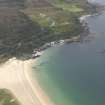Colonsay, Uamh Ur, Kiloran Bay
Cave (Period Unassigned)
Site Name Colonsay, Uamh Ur, Kiloran Bay
Classification Cave (Period Unassigned)
Canmore ID 37881
Site Number NR39NE 9
NGR NR 3959 9792
Datum OSGB36 - NGR
Permalink http://canmore.org.uk/site/37881
- Council Argyll And Bute
- Parish Colonsay And Oronsay
- Former Region Strathclyde
- Former District Argyll And Bute
- Former County Argyll
NR39NE 9 3959 9792.
(Name: NR 396 979) Uamh Ur (NAT)
OS 6" map (1900)
Uamh Ur - "New Cave" - or Crystal Spring Cavern, a large, 3-chambered cave whose floor displays evidence of early occupation overlaid by stalagmite formations. A possible dating for this occupation is provided by the finding of an Early Iron Age pot and evidence of the probable use of iron.
The entrance to the cave, in a mass of fallen rock 40' above sea level, at the base of a 24' high cliff, is about 19 1/2' broad and faces ENE and is set about 30' above the level of the outer chamber of the cave, the descent being over masses of fallen rock partly covered by earth. The interior is in darkness.
In the SW corner of the outer chamber, which has a maximum height of 15 1/2', is a clear spring from which Grieve and D F Howarth, who discovered the evidence of occupation in 1879, named the cave Crystal Spring Cavern, the local name being Uamh Ur, 'the New Cave' from its having been discovered only about the mid-18th century. A 2'10" deep cutting near the entrance revealed successive deposits of a mixture of charcoal, bones, earth and stones, the strata being separated by thin layers of clay.
The Early Iron Age pot was donated to the NMAS by J Crawford, Campbeltown, in 1964-6.
S Grieve 1880; 1883; Proc Soc Antiq Scot 1967
NR 3959 9792: The cave is as described and planned. There are several shell deposits within it but no finds were made.
Surveyed at 1:2500.
Visited by OS (DWR) 16 April 1974




















